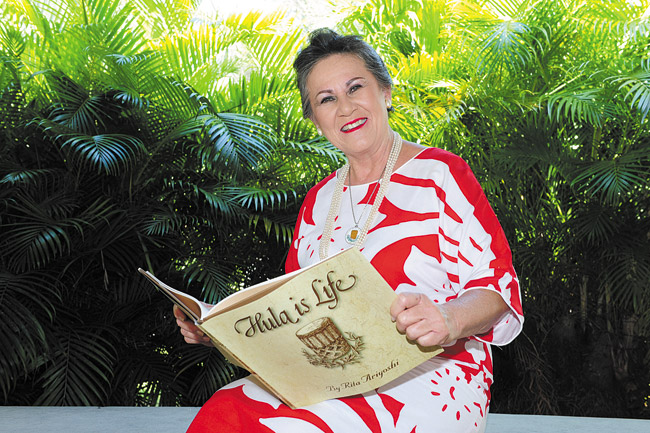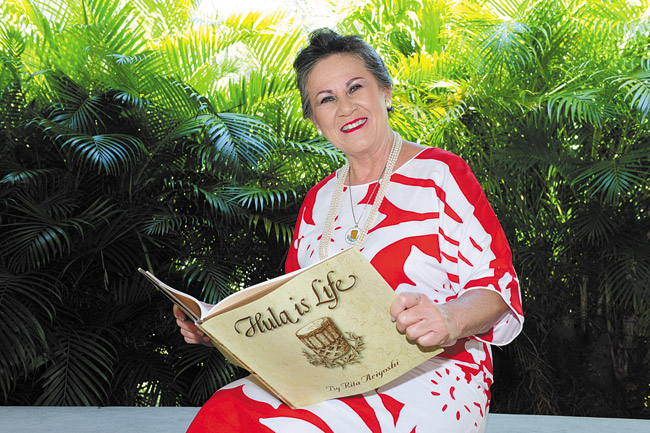Remembering The Grand Dame Of Hula
The daughter of Aunti Maiki Aiu Lake carries on her traditional hula ways, and the halau is planning its 30th annual celebration in her honor
How does one pay tribute to the legacy of a kumu hula? Are there enough graceful hula motions, fragrant lei and rainbows to adequately express love and devotion?
mw-nm-040214-coline-aiu-1
What of the haumana (“students”) who inherit the traditions and teachings of the kumu (“teacher”)?
In the case of the late Maiki Aiu Lake, her memory lives in an annual event known as Kahikolu (Hawaiian for “three-in-one”). This year, Halau Hula O Maiki, the hula academy founded by Lake, will stage the 30th edition of Kahikolu on Memorial Day, Monday, May 26, 11 a.m. to 2 p.m., at Saint Francis School, 2707 Pamoa Road in Manoa.
Founder’s Day honoring Aunti Maiki, as she is known affectionately to her students, might be lesser known, but certainly her reputation and treasured cultural lessons are not.
Lake personified her Hawaiian heritage. Through hula, she left an enduring imprint on the arts of Hawaii.
Mention prominent and respected exponents of hula today, and it’s likely Lake trained them or influenced their development as teachers. Her graduates include Robert Cazimero, Mapuana de Silva, John Kahai Topolinski, Milton I and Leinaala Kalama Heine, among others.
But the person most identified with Lake and endowed with her vibrant spirit is her daughter Coline Helen Kaualoku Aiu (Miss Coline).
Aiu is kumu hula of Halau Hula O Maiki, started by her mother in 1946 in the family living room. From a modest start of eight students in Pauoa Valley, the academy of traditional hula has grown to 200 dancers, each nurtured by learning disciples and cultural perspectives shaped by Lake.
The halau is based at 2347 Dole St. near the University of Hawaii. Nestled among coconut trees, it is now the permanent home of Halau Hula O Maiki, which was previously at Waikiki, Keeaumoku Street, Puck’s Alley in Moiliili and South Beretania Street.
“I was a very poor student of the hula in my younger years,” Aiu admits. “But at age 13, when I wanted to buy a surfboard, dancing became a way to earn $10 a week while performing at the Kaimana Beach Hotel. The more I danced hula, the more I realized there was a lot more to it. In teaching hula, my mother didn’t just do the motions. She’d explain the history, language and mannerisms of the dance.
“My mother’s choreography is simple. The movements flow. Nothing is abrupt. It is up to the dancer to express the living poetry,” Aiu explains in the book Hula is Life by Rita Ariyoshi, a member of the halau since 1989.
The fifth of seven children, she further perpetuates her mother’s legacy with an unwavering devotion to traditional hula methods and style.
“It is important for me to present the halau as my mother always did, to maintain her goals and her caliber of instruction,” says Aiu, who was Miss Hawaii 1974.
“Halau doesn’t just happen. You need commitment.”
Originally known as Margaret Aiu’s Hula Studio, Lake’s masterful techniques and uncompromising standards of dance and character development – teaching hula from the inside out – are hallmarks of excellence today.
In 1952, she sought permission from the elders to use the term halau. She pioneered the use of large classes that recorded lessons in notebooks instead of relying on oral tradition. Lake taught all who wanted to learn, regardless of race or age, wrote Dr. Ishmael Stag-ner in his book Kumu Hula Roots and Branches.
It was a turning point in the way hula was taught and how halau are regarded in the community today.
It is this commitment that brings 300-400 devotees of Aunti Maiki to Kahikolu each year.
On Memorial Day, they give her a party so grand she can hear it in heaven. A family gathering of graduates enjoy food, fun and plenty of Hawaiian music. As familiar hula music is played, each spontaneously gets up to dance.
Proceeds from the event, which is open to the public, are donated to Saint Francis School.
Underlying the festivity of Kahikolu are three symbolic virtues of faith, hope and love, the guiding principles of Lake’s life. Embracing these values, the devoted kumu hula overcame personal and professional challenges to establish her dream, a dance academy built on classic Hawaiian traditions and practice. Lake not only was a forerunner, she also was a conduit through which the mastery of Iolani Luahine, Mary Kawena Pukui and Lokalia Montgomery was passed on.
Now Miss Coline carries on that tradition, casting a shadow as broadly as her revered mother. She recalls her mother admonishing, “This knowledge that I have, I give to you, but it will always be mine until you know how to take care of it, keep it, treasure it and love it.”
Kahikolu May 26 is an affirmation of that commitment. There’s no better purpose for a jubilant party.
Specially designed Kahikolu T-shirts at $25 each serve as admission to the event. Call 699-HULA (4852).







